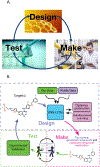The Commoditization of AI for Molecule Design
- PMID: 36211981
- PMCID: PMC9541920
- DOI: 10.1016/j.ailsci.2022.100031
The Commoditization of AI for Molecule Design
Abstract
Anyone involved in designing or finding molecules in the life sciences over the past few years has witnessed a dramatic change in how we now work due to the COVID-19 pandemic. Computational technologies like artificial intelligence (AI) seemed to become ubiquitous in 2020 and have been increasingly applied as scientists worked from home and were separated from the laboratory and their colleagues. This shift may be more permanent as the future of molecule design across different industries will increasingly require machine learning models for design and optimization of molecules as they become "designed by AI". AI and machine learning has essentially become a commodity within the pharmaceutical industry. This perspective will briefly describe our personal opinions of how machine learning has evolved and is being applied to model different molecule properties that crosses industries in their utility and ultimately suggests the potential for tight integration of AI into equipment and automated experimental pipelines. It will also describe how many groups have implemented generative models covering different architectures, for de novo design of molecules. We also highlight some of the companies at the forefront of using AI to demonstrate how machine learning has impacted and influenced our work. Finally, we will peer into the future and suggest some of the areas that represent the most interesting technologies that may shape the future of molecule design, highlighting how we can help increase the efficiency of the design-make-test cycle which is currently a major focus across industries.
Keywords: Artificial intelligence; design-make-test; machine learning; molecule design; recurrent neural networks.
Conflict of interest statement
Conflicts of interest S.E. is owner, and F.U. is an employee of Collaborations Pharmaceuticals, Inc.
Figures



References
-
- Ozin G, Siler T. Autonomous chemical synthesis. 2020. https://www.advancedsciencenews.com/autonomous-chemical-synthesis/
-
- Sanderson K. Automation: Chemistry shoots for the Moon. Nature. 2019;568:577–9. - PubMed
-
- Bedard AC, Adamo A, Aroh KC, Russell MG, Bedermann AA, Torosian J, et al. Reconfigurable system for automated optimization of diverse chemical reactions. Science. 2018;361:1220–5. - PubMed
-
- Coley CW, Thomas DA 3rd, Lummiss JAM, Jaworski JN, Breen CP, Schultz V, et al. A robotic platform for flow synthesis of organic compounds informed by AI planning. Science. 2019;365:eaax1566. - PubMed
Grants and funding
LinkOut - more resources
Full Text Sources
Miscellaneous
